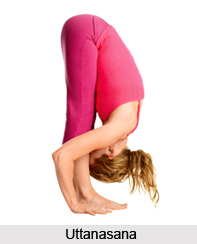 Uttanasana is a cultural asana that tones the hamstrings through a forwarding bending pose. It is a fairly recent addition to the asana compendium and few classic texts describe or mention the posture.
Uttanasana is a cultural asana that tones the hamstrings through a forwarding bending pose. It is a fairly recent addition to the asana compendium and few classic texts describe or mention the posture.
Meaning of Uttanasana
The literal meaning of root word "Ut" is intense. Tan means to stretch or extend. Essentially, the asana is a forward bending pose that stretches the entire body, bringing the face close to the shins, hence given the name of the intense stretch pose.
Yoga Texts and Uttanasana
Uttanasana is a fairly recent addition to the Yoga Asana compendium, first mentioned in the Shri Tattva Nidhi, a Hindu treatise compiled in princely state of Mysore in the 19th century CE
Practice of Uttanasana
* Stand in Tadasana, with hands resting on hips.
* Exhale and bend forward from the hip joints, not from the waist. As one descends draw the front torso out of the groin and open the space between the pubis and top sternum. As in all the forward bends, the emphasis is on lengthening the front torso as one moves more fully into the position.
* If possible, with the knees straight, bring the palms or fingertips to the floor slightly in front of or beside the feet, or bring the palms to the backs of the ankles. If this is not possible, cross forearms and hold the elbows. Press the heels firmly into the floor and lift the buttocks toward the ceiling.
* Turn the top thighs slightly inward.
* With each inhalation in the pose, lift and lengthen the front torso just slightly; and with each exhalation, release a little more fully into the forward bend. In this way the torso oscillates almost imperceptibly with the breath.
* Let your head hang from the root of the neck, which is deep in the upper back, between the shoulder blades.
* Stay in the pose for 30 seconds to 1 minute.
* Do not roll the spine to come up. Instead bring your hands back onto your hips and reaffirm the length of the front torso.
* Then press your tailbone down and into the pelvis and come up on an inhalation with a long front torso.
Uttanasana can be used as a resting position between the standing poses. It can also be practiced as a pose in itself.
In order to increase the stretch in the backs of your legs, bend your knees slightly. Imagine that the sacrum is sinking deeper into the back of your pelvis and bring the tailbone closer to the pubis. Then against this resistance, push the top thighs back and the heels down and straighten the knees again. Be careful not to straighten the knees by locking them back (you can press your hands against the back of each knee to provide some resistance); instead let them straighten as the two ends of each leg move farther apart.
Effects of Uttanasana
* Calms the brain and helps relieve stress and mild depression
* Stimulates the liver and kidneys
* Stretches the hamstrings, calves, and hips
* Strengthens the thighs and knees
* Improves digestion
* Helps relieve the symptoms of menopause.
* Reduces fatigue and anxiety
* Relieves headache and insomnia.
* Therapeutic for asthma, high blood pressure, infertility, osteoporosis, and sinusitis.
Precautions in practice of Uttanasana
In case of back injury perform this pose with bent knees, perform Ardha Uttanasana (with the hands on the wall, legs perpendicular to your torso, and arms parallel to the floor.



